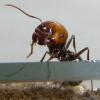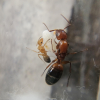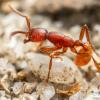- Formiculture.com
- Forums
- Gallery
- Members
- Member Map
- Chat

What Qualifies As A “Cryptic” Ant?
Started By
The_Gaming-gate
, Apr 8 2024 1:11 AM
9 replies to this topic
#1
 Offline
-
Posted April 8 2024 - 1:11 AM
Offline
-
Posted April 8 2024 - 1:11 AM
I have seen this term being thrown around a bit, but am clueless to what it actually means.
- futurebird likes this
Ants are small creatures... but together... they can rule the world.
#2
 Online
-
Posted April 8 2024 - 11:48 AM
Online
-
Posted April 8 2024 - 11:48 AM
They are ants that lead a hidden life.
A cryptic species in biology is actually one that looks very similar to another, but is actually their own thing.
In ants, when we hear cryptic, we mean the small hidden ant species that live underground and are rarely seen.
Species that are inconspicuous, small, nocturnal, only have small colonies and maybe never come to the surface.
I recommend reading "Adventures among Ants" by Mark Moffett, it is an exciting tale of the author traveling the world and looking for different and interesting ant species.
He also describes several cryptic species, among them a species of army ant that purely lives underground and is hardly ever seen!
I personally keep an ant species, Camponotus piceus, which is close to a cryptic species (it is reported as "rare" in Germany, probably because it is hard to see and find). This species stays small (around 200 workers in the colony), their nest entrance is inconspicuous (a simple hole in the ground), they forage alone, they do not form the typical ant highways and they do not fight but run away.
- futurebird likes this
#3
 Offline
-
Posted April 8 2024 - 1:24 PM
Offline
-
Posted April 8 2024 - 1:24 PM
They are ants that lead a hidden life.
A cryptic species in biology is actually one that looks very similar to another, but is actually their own thing.
In ants, when we hear cryptic, we mean the small hidden ant species that live underground and are rarely seen.
Species that are inconspicuous, small, nocturnal, only have small colonies and maybe never come to the surface.
I recommend reading "Adventures among Ants" by Mark Moffett, it is an exciting tale of the author traveling the world and looking for different and interesting ant species.
He also describes several cryptic species, among them a species of army ant that purely lives underground and is hardly ever seen!
I personally keep an ant species, Camponotus piceus, which is close to a cryptic species (it is reported as "rare" in Germany, probably because it is hard to see and find). This species stays small (around 200 workers in the colony), their nest entrance is inconspicuous (a simple hole in the ground), they forage alone, they do not form the typical ant highways and they do not fight but run away.
Thank you so much! I was real confused for a second.
Ants are small creatures... but together... they can rule the world.
#4
 Offline
-
Posted April 11 2024 - 5:33 AM
Offline
-
Posted April 11 2024 - 5:33 AM
Thank you so much! I was real confused for a second.They are ants that lead a hidden life.
A cryptic species in biology is actually one that looks very similar to another, but is actually their own thing.
In ants, when we hear cryptic, we mean the small hidden ant species that live underground and are rarely seen.
Species that are inconspicuous, small, nocturnal, only have small colonies and maybe never come to the surface.
I recommend reading "Adventures among Ants" by Mark Moffett, it is an exciting tale of the author traveling the world and looking for different and interesting ant species.
He also describes several cryptic species, among them a species of army ant that purely lives underground and is hardly ever seen!
I personally keep an ant species, Camponotus piceus, which is close to a cryptic species (it is reported as "rare" in Germany, probably because it is hard to see and find). This species stays small (around 200 workers in the colony), their nest entrance is inconspicuous (a simple hole in the ground), they forage alone, they do not form the typical ant highways and they do not fight but run away.
Here in Florida, a lot of our cryptic ants are extremely tiny, leaf litter dwelling species such as Strumigenys. From what I have read, you can sometimes also find them in rotted wood and even sometimes in soil, however as far as I know, they are most commonly found in leaf litter.
I have yet to ever find a Strumigenys species in the wild, unfortunately, and have only ever seen them in pictures. They're cute little trapjaws that are very tiny!
- futurebird, bmb1bee, SHmealer and 1 other like this
#5
 Offline
-
Posted April 11 2024 - 11:07 AM
Offline
-
Posted April 11 2024 - 11:07 AM
Here in Florida, a lot of our cryptic ants are extremely tiny, leaf litter dwelling species such as Strumigenys. From what I have read, you can sometimes also find them in rotted wood and even sometimes in soil, however as far as I know, they are most commonly found in leaf litter.Thank you so much! I was real confused for a second.They are ants that lead a hidden life.
A cryptic species in biology is actually one that looks very similar to another, but is actually their own thing.
In ants, when we hear cryptic, we mean the small hidden ant species that live underground and are rarely seen.
Species that are inconspicuous, small, nocturnal, only have small colonies and maybe never come to the surface.
I recommend reading "Adventures among Ants" by Mark Moffett, it is an exciting tale of the author traveling the world and looking for different and interesting ant species.
He also describes several cryptic species, among them a species of army ant that purely lives underground and is hardly ever seen!
I personally keep an ant species, Camponotus piceus, which is close to a cryptic species (it is reported as "rare" in Germany, probably because it is hard to see and find). This species stays small (around 200 workers in the colony), their nest entrance is inconspicuous (a simple hole in the ground), they forage alone, they do not form the typical ant highways and they do not fight but run away.
I have yet to ever find a Strumigenys species in the wild, unfortunately, and have only ever seen them in pictures. They're cute little trapjaws that are very tiny!
Oh wow, they look so cool. The closest looking thing I’ve found is a generic black trapjaw from the Odontomachus genus.
Ants are small creatures... but together... they can rule the world.
#6
 Offline
-
Posted April 11 2024 - 10:26 PM
Offline
-
Posted April 11 2024 - 10:26 PM
Most cryptic ants are also blind, or at least have relatively poor eyesight. In my area, this includes genera like Hypoponera, Stenamma, aand Myrmecina.
- The_Gaming-gate likes this
"Float like a butterfly sting like a bee, his eyes can't hit what the eyes can't see." - Muhammad Ali
Check out my shop and Camponotus journal! Discord user is bmb1bee if you'd like to chat.
#7
 Offline
-
Posted April 12 2024 - 3:47 AM
Offline
-
Posted April 12 2024 - 3:47 AM
Here in Florida, a lot of our cryptic ants are extremely tiny, leaf litter dwelling species such as Strumigenys. From what I have read, you can sometimes also find them in rotted wood and even sometimes in soil, however as far as I know, they are most commonly found in leaf litter.Thank you so much! I was real confused for a second.They are ants that lead a hidden life.
A cryptic species in biology is actually one that looks very similar to another, but is actually their own thing.
In ants, when we hear cryptic, we mean the small hidden ant species that live underground and are rarely seen.
Species that are inconspicuous, small, nocturnal, only have small colonies and maybe never come to the surface.
I recommend reading "Adventures among Ants" by Mark Moffett, it is an exciting tale of the author traveling the world and looking for different and interesting ant species.
He also describes several cryptic species, among them a species of army ant that purely lives underground and is hardly ever seen!
I personally keep an ant species, Camponotus piceus, which is close to a cryptic species (it is reported as "rare" in Germany, probably because it is hard to see and find). This species stays small (around 200 workers in the colony), their nest entrance is inconspicuous (a simple hole in the ground), they forage alone, they do not form the typical ant highways and they do not fight but run away.
I have yet to ever find a Strumigenys species in the wild, unfortunately, and have only ever seen them in pictures. They're cute little trapjaws that are very tiny!
Oh wow, they look so cool. The closest looking thing I’ve found is a generic black trapjaw from the Odontomachus genus.
I have a colony of Odontomachus haematodus at the base of the pecan tree in my front yard and they're highly aggressive and quite large.
I'm not a fan of semi claustral species, however, and I don't think I'd give them an attempt as a species for me to keep.
- The_Gaming-gate likes this
#8
 Offline
-
Posted April 12 2024 - 4:28 AM
Offline
-
Posted April 12 2024 - 4:28 AM
Semi-claustrals don’t seem easy to found, but they all have these amazing characteristics that I’d love to watch.I have a colony of Odontomachus haematodus at the base of the pecan tree in my front yard and they're highly aggressive and quite large.Oh wow, they look so cool. The closest looking thing I’ve found is a generic black trapjaw from the Odontomachus genus.Here in Florida, a lot of our cryptic ants are extremely tiny, leaf litter dwelling species such as Strumigenys. From what I have read, you can sometimes also find them in rotted wood and even sometimes in soil, however as far as I know, they are most commonly found in leaf litter.Thank you so much! I was real confused for a second.They are ants that lead a hidden life.
A cryptic species in biology is actually one that looks very similar to another, but is actually their own thing.
In ants, when we hear cryptic, we mean the small hidden ant species that live underground and are rarely seen.
Species that are inconspicuous, small, nocturnal, only have small colonies and maybe never come to the surface.
I recommend reading "Adventures among Ants" by Mark Moffett, it is an exciting tale of the author traveling the world and looking for different and interesting ant species.
He also describes several cryptic species, among them a species of army ant that purely lives underground and is hardly ever seen!
I personally keep an ant species, Camponotus piceus, which is close to a cryptic species (it is reported as "rare" in Germany, probably because it is hard to see and find). This species stays small (around 200 workers in the colony), their nest entrance is inconspicuous (a simple hole in the ground), they forage alone, they do not form the typical ant highways and they do not fight but run away.
I have yet to ever find a Strumigenys species in the wild, unfortunately, and have only ever seen them in pictures. They're cute little trapjaws that are very tiny!
I'm not a fan of semi claustral species, however, and I don't think I'd give them an attempt as a species for me to keep.
Ants are small creatures... but together... they can rule the world.
#9
 Offline
-
Posted April 12 2024 - 5:53 AM
Offline
-
Posted April 12 2024 - 5:53 AM
Yeah, I would never hate on semi, I just don't feel like doing all of that extra stuff that they require. Maybe when I'm more experienced at keeping ants, but fully claustrals keep me busy enough as is so I'm just sticking with them for now lol.
#10
 Offline
-
Posted April 12 2024 - 10:24 AM
Offline
-
Posted April 12 2024 - 10:24 AM
Crypsis generally is understood as a species population that from general or even more detail morphological characters are indistinguishable from another. Often times crypsis implies that a population is considered a single species which in fact is not, i.e., there is enough genetic diversity to warrant separate species population categories, lack of gene transfer which may occur via asympatric distribution or allochronic (disjunct) mating times that entails, again, lack of gene transfers; the upshot, more than one single species is occurring in what is considered a singular species population.
A cryptic species though is one which may be hidden or only rarely collected, so do not confuse being cryptic with crypsis.
- gcsnelling, Ernteameise and The_Gaming-gate like this
0 user(s) are reading this topic
0 members, 0 guests, 0 anonymous users
















